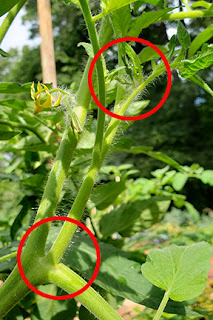Since it is past seed starting time I will skip past that in this post and go straight to getting them in the ground and caring for them. Every year at tomato planting time I break out my fishing gear and head to my favorite spot to fish for fertilizer. I don't care what I catch, but I don't take large or desirable fish out of the lake. I will let someone who will eat them have those. What I want are the small guys and bottom feeders that no one will miss. Pumpkin Seed, small bluegill and catfish are what I hope to catch. Once I have a bucket full of fish I will head home and begin to plant my tomatoes. I dig a deep hole and place a piece of fish at the bottom of the hole. Then I trim off the bottom set of leaves or two depending on the size of the tomato seedling, and plant the tomato in the ground on top of the piece of fish then I cover them with dirt above where I trimmed off the leaves. Tomato can be planted deep in the soil. They will grow roots all along their stems which will help to anchor it and draw up more nutrients making for a stronger tomato plant. The fish is easy to access nutrition for the tomato while it is establishing in its permanent location.
Readily available natural fertilizer to give my tomato the best start in life possible.
Half a Pumpkin Seed fish at the bottom of the tomato hole will provide easy to access nutrients and help prevent transplant shock.
This seedling is ready for planting. It is large enough to stand up to some wind and driving rain and has plenty of leaf branches.
Here I have removed the bottom couple leaf branches so that I can plant it deeply in the soil.
The plant is deeply planted and will grow roots all along the stem under the soil to provide stability and better uptake of nutrients.
Here is what the plant looks like 6 weeks after planting. Healthy and laden with ripening fruit.
Once the tomato is given a nice deep hole and some easy to access nutrients, the next thing to consider is how to keep the plant healthy. Here in North Carolina, Early Blight is a real problem. Early Blight is a soil borne fungus that causes the leave to yellow and wither and will reduce the plants production substantially
 |
| Early Blight fungus takes a perfectly health plant and reduces it to yellowing leaves and bare vines. (Photo from Google search no photo credits given) |
 |
| Early Blight will also reduce production and cause misshapen or small fruit (Photo from Google search no photo credits given) |
It is very simple to prevent Early Blight. Since it is a soil borne fungus, all that must be done to prevent it is to provide a deep mulch or ground cover under the tomato plants that keeps soil from splashing up on the leaves. I use a landscaping cloth that easily passes water, bu prevents splash. It has the added benefit of suppressing weeds. Most years I also put a layer of wood mulch on top of the cloth to further prevent splash and help to hold in moisture.
Tomatoes prefer to be watered at their roots. Although this isn't always possible, if it is it will help to prevent fusarium wilt and powdery mildew. If you have these problems, then it is important to water at the roots and never touch the leaves of the plant when they are wet.
Tomato Hornworms can wreak havoc on your plants as well. There are a few tried and true organic ways to eliminate them. You can spray your plants with Bt, (Bacillus Thuringiensis, trade name Dipel) at the first sign of damage. It is a naturally occurring bacterium, that paralyzes the digestive system of leaf eating caterpillars. It is safe for humans animals and beneficial insects with the exception of butterfly caterpillars, so be sure to avoid getting the Bt on the plants where butterfly caterpillar feed, like dill, parsley and milkweed. I don't use Bt on my tomatoes, but I do use it on anything in the cabbage family since looper worms are difficult to control any other way. The reason I choose not to use it on my tomatoes is because it is easy to see where the worm are at work and pick them off and destroy them,. This given me one less area I need to spray. The only time I leave the caterpillars alone is when they have little white cocoons on their backs. The natural predator of the Tomato Hornworn is a parasitic wasp that lays its young in the back of the Hornworm. The young feed on the caterpillar, killing it and creating more predators for the worms.
 |
| Tomato Hornworm (Photo from Google search no photo credits given) |
 |
| Remove but do not destroy the caterpillar that has these cocoons on its back. (Photo from Google search no photo credits given) |
Now that the tomato is protected from disease and pests, the next concern is how to increase productivity and quality of the tomato fruits. Tomatoes are heavy feeders so I feed mine a side dressing of compost when hey begin to bear fruit and feed them with a diluted solution of fish emulsion as a foliar feeding and at the roots every few weeks. Feeding is important, but the plants will really excel when they are judicially pruned to channel the strength of the plant to fruit production instead of spending energy on foliage. It also helps light reaches the fruit and helps the bees to find the flowers to pollinate.
I know that there is much talk in gardening circles about pinching "suckers" to increase production. But it is important to understand what the sucker really is. It is said that little leaflets that appear in the crotch of the stem and tomato branch are the "suckers" that tomato growers are encouraged to pinch, but if you pay attention to the habits of the tomato plant you will see that this in incorrect. In truth, the leaflet in the crotch will become a fruiting branch and the leafy branch that it is attached to to the stem of the tomato is actually the part that need to be removed. If you look closely you will notice that as the leaflet in the crotch grows, the leafing branch below will bend downward. This leafing branch will never produce flowers and should be removed, not the leaflet.
In the following series of photos I will plead my case and you can see if you agree with me. Below is a photo of the stem and leafing branch with the "sucker" growing in the crotch.
 |
| It has been said that the "sucker" should be pinched, but in doing so you are actually removing the fruiting stem and leaving an non producting leafy branch. |
When the leaflet in the crotch is a couple inches tall and the leafing branch is beginning to point downwards it is time to prune off the leafy branch leaving the center leaflet to become a fruiting branch.
The bottom circle shows that this is the leaflet growing in the crotch, the top circle shows the forming flower spurs. If you had pinched this as a "sucker" you would have reduced your production by 4 to 6 tomatoes for each one you pinched out.
Hopefully this is not confusing. I have tried to lay it out clearly, but if anyone doesn't understand, leave a comment and I will try to clarify.
Well I have probably talked enough about tomatoes today so I will stop here and continue next time with how I increase productivity in Determinate tomato varieties. Hope to see you then!
As always I love comments. They help me to feel like I am not just talking to myself :) Please feel free to ell me what you think or just to say "howdy!"

















